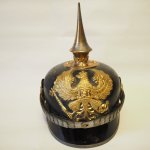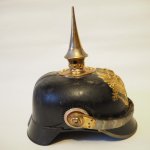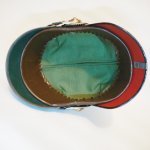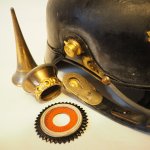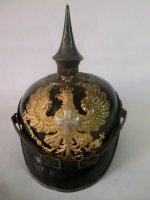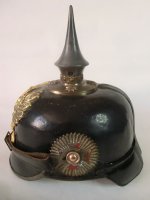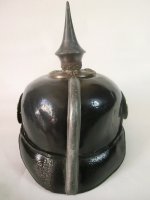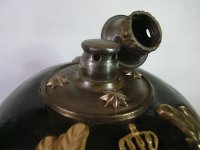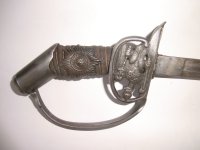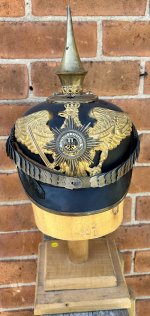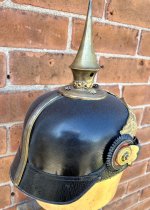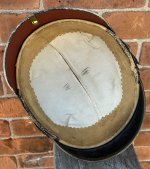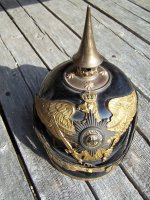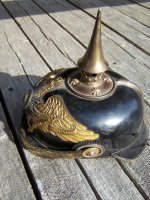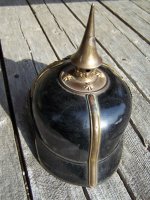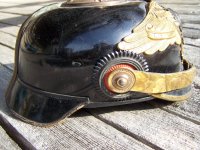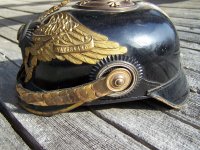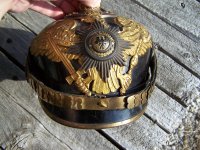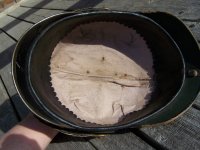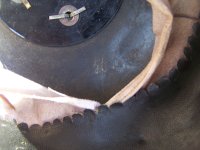Background: As the war progressed, the Germans just as in WW2 suffered from a metals shortage. Consequently, they turned to substitutes and in this case we see an example of zinc helmet fittings. When zinc was used for a "brass type" helmet, the fittings had some sort of gold coloured wash on them to simulate brass. The same for neusilber fittings...a silver wash over zinc.
Description: The piece shown here, is a Prussian Dragoon officer from a regiment which had silver buttons on their tunics (pre 1910) and silver (nickel plated) helmet fittings. In my experience, the manufacturers during the war tried to maintain pre war quality for the wappen and used whatever nickel plated/zinc combinations to complete the helmet. This is what we see in the example shown here:
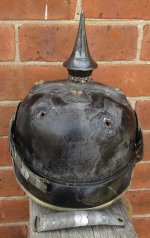
Typically the silver/gold wash disappears over time revealing the zinc beneath. So here we see...zinc chin scales, zinc spike and base BUT brass stars. If you look closely, the visor trim is also pre war nickel plated.
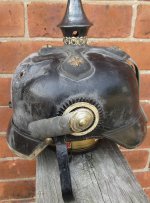
A side view showing more mixed parts....neusilber rosettes. The officer kokarde ring has also been repainted by some collector because it is also grey zinc. Last, the "pearl ring" on the spike neck is pre war quality.
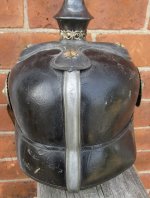
A zinc spine.
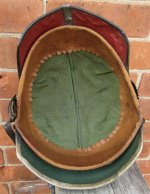
The interior is in excellent condition and pre war quality. Many of these mid war officer helmets had different cloth used which was of poor quality and simply falls apart over time.

The Reich kokarde ring has also been repainted to hide the zinc. Again, a nice cavalry style convex rosette which fits tightly over the scale.
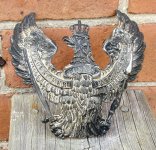
A pre war officer wappen, heavily oxidized but still showing parts of the original frosting.
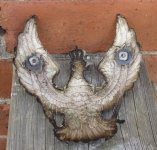
The reverse, showing steel posts and steel nuts. Pre 1914 these would have been in brass. The spike base stars also have brass prongs instead of screw posts, which is another indication of wartime production. Last, although not shown here, many wartime officer wappen have soldered wappen prongs instead of the usual screw posts. So if you see one of these, this gives you a reference for when it was made.
Summary: This is a great example of the mix of pre war and zinc fittings which you will find on wartime officer helmets. I was offered this helmet for purchase but turned it down as most collectors either rightly or wrongly do not want these helmets. These pieces are totally legitimate but they are not pleasing to the eyes my opinion only. WW2 collectors will also know about "pot metal" badges, this is the WW1 version being shown here. One last bit of information....I did have a Prussian infantry officer wappen in zinc years ago so you may encounter that as well. In my experience though, as stated at the beginning a zinc officer wappen is rare.
my opinion only. WW2 collectors will also know about "pot metal" badges, this is the WW1 version being shown here. One last bit of information....I did have a Prussian infantry officer wappen in zinc years ago so you may encounter that as well. In my experience though, as stated at the beginning a zinc officer wappen is rare.
Description: The piece shown here, is a Prussian Dragoon officer from a regiment which had silver buttons on their tunics (pre 1910) and silver (nickel plated) helmet fittings. In my experience, the manufacturers during the war tried to maintain pre war quality for the wappen and used whatever nickel plated/zinc combinations to complete the helmet. This is what we see in the example shown here:

Typically the silver/gold wash disappears over time revealing the zinc beneath. So here we see...zinc chin scales, zinc spike and base BUT brass stars. If you look closely, the visor trim is also pre war nickel plated.

A side view showing more mixed parts....neusilber rosettes. The officer kokarde ring has also been repainted by some collector because it is also grey zinc. Last, the "pearl ring" on the spike neck is pre war quality.

A zinc spine.

The interior is in excellent condition and pre war quality. Many of these mid war officer helmets had different cloth used which was of poor quality and simply falls apart over time.

The Reich kokarde ring has also been repainted to hide the zinc. Again, a nice cavalry style convex rosette which fits tightly over the scale.

A pre war officer wappen, heavily oxidized but still showing parts of the original frosting.

The reverse, showing steel posts and steel nuts. Pre 1914 these would have been in brass. The spike base stars also have brass prongs instead of screw posts, which is another indication of wartime production. Last, although not shown here, many wartime officer wappen have soldered wappen prongs instead of the usual screw posts. So if you see one of these, this gives you a reference for when it was made.
Summary: This is a great example of the mix of pre war and zinc fittings which you will find on wartime officer helmets. I was offered this helmet for purchase but turned it down as most collectors either rightly or wrongly do not want these helmets. These pieces are totally legitimate but they are not pleasing to the eyes
Last edited:

